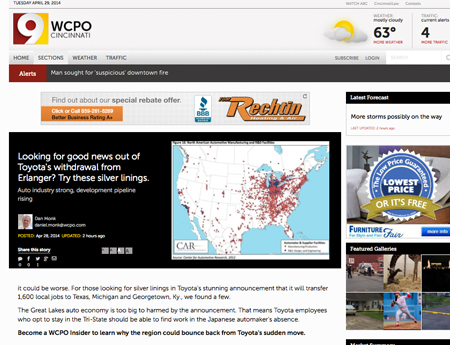Scripps Looks ‘Inside’ for New Revenue

Months after it debuted one of the boldest moves in local TV, Scripps has gathered a bunch of information on its WCPO.com paywall, and the “Insiders” who pay for its content. It’s a risky strategy—WCPO has hired 30 staffers, including well-established local journalists, on the assumption that users would find their work worth paying for.
WCPO’s is the only such model in local broadcast, but Adam Symson, Scripps senior VP and chief digital officer, says the station is well positioned to make the “business to consumer” relationship flourish. “We’re just not satisfied to allow newspapers to own that relationship with consumers,” he says.
Penny For Your Thoughts
Symson declined to share subscriber or revenue figures for “WCPO Insider,” but did say that page views on WCPO.com are up 30% quarter over quarter, with unique visitors up 21%. Most of the content remains free while stories with a “9” icon—on politics, the arts, business, etc.—are behind a paywall. The station is currently charging a penny for four weeks of Insider content, then $7.99 per month after that, or $79.99 for the year. Jeff Brogan, WCPO VP and general manager, refers to the gated material as “in-depth, exclusive content you don’t get anywhere else.”
The subscription model kicked in in January. WCPO.com clearly wants to provide the depth on stories that consumers associate with print publications, such as Gannett’s Cincinnati Enquirer and the American City Business Journals-owned Cincinnati Business Courier.
Insider’s full might was on display, says Symson, when Toyota announced it was closing its operation in neighboring northern Kentucky—a major story with various compelling angles. “The resources we were able to deliver to the station audience and the digital audience clearly allowed us to outshine the competition,” Symson says.
Critics Not Buying It
The smarter way to stay on top of broadcasting and cable industry. Sign up below
Cincinnati media veterans don’t seem concerned with WCPO’s new model. Two suggest that the very customers Scripps is targeting— savvy news hounds—are probably clever enough to find ways around the paywall. Jamie Smith, publisher of Cincinnati Business Courier, says his publication still gets the big business scoops. “I think they’re getting a lot of pushback from the marketplace that’s so used to getting what they want for free,” says Smith.
Jeff Jarvis, professor of journalism at City University of New York, did not see anything “brilliant or different,” he says, upon scanning WCPO.com’s gated offerings. “I just see more of the same stuff with random 9s before them,” he says.
Cincinnati is an ideal test market for Scripps: It’s the company’s home base; its booming business scene is home to Procter & Gamble, Macy’s and many other global corporations; and people there are exceptionally passionate about the market, believes Symson. Plans for the next Scripps TV market to try out a paywall may be drawn up later this year. “We have to execute here in this market and make sure we hit all our benchmarks,” Symson says, “before we run off down the road.”
Michael Malone is content director at B+C and Multichannel News. He joined B+C in 2005 and has covered network programming, including entertainment, news and sports on broadcast, cable and streaming; and local broadcast television, including writing the "Local News Close-Up" market profiles. He also hosted the podcasts "Busted Pilot" and "Series Business." His journalism has also appeared in The New York Times, The L.A. Times, The Boston Globe and New York magazine.

